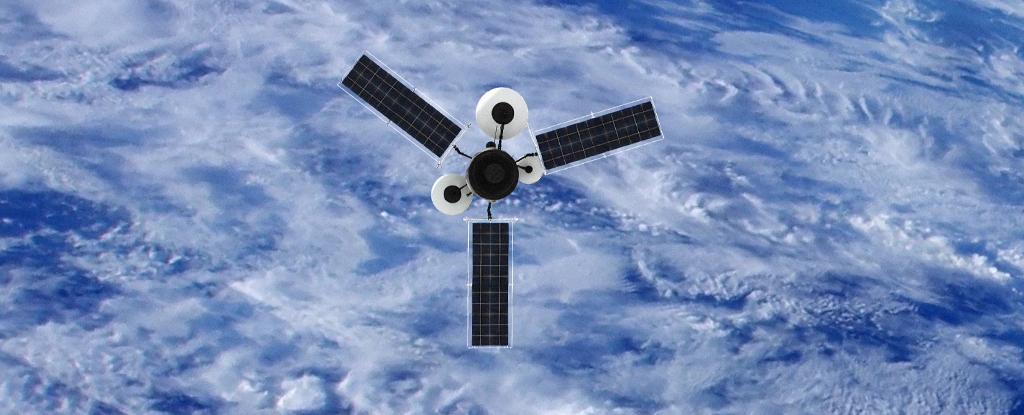So instead of just losing Ukraine, lose Russia and 50+% of life on Earth instead.
You do realise that that newspaper article was almost two years old?
So instead of just losing Ukraine, lose Russia and 50+% of life on Earth instead.
So was the person it quoted by the sounds of things.You do realise that that newspaper article was almost two years old?
I imagine whatever this it’s probably specifically designed to take out something like Starlink, for that to work it would have to cripple a lot of satellites with each ‘shot’ hence the high power needs.Based on article from previous page Ekipazh is just EW satellite. Just Krasukha system but in orbit. Still dangerous because orbiting below GPS and Around Starlinks so the signal is at similar level or stronger.
Ekipazh - Space-Based Jammer
www.globalsecurity.org
The Outer Space Treaty is not a non-aggression treaty, there is no legal basis to claim it is nullified by a terrestrial conflict.In this case, I think the Russians are right. If the U.S. helps Ukraine with weapons, its attitude nullifies any previous non-aggression treaty with the USSR.
The Outer Space Treaty is not a non-aggression treaty, there is no legal basis to claim it is nullified by a terrestrial conflict.
Yes because since late 2015 it’s been the GOP using “Russia” to instil fear in voters.
Makes a lot more sense than using nukes to take out satellites.
Makes a lot more sense than using nukes to take out satellites.
Yes, an EMP would wreck havoc. The Russians would not use it, but Putin probably would.More concerning: a small nuke set off in orbit, especially LEO, would create an EMP on the surface below it.
"Whoopsie, we were just trying to take out a Starlink sat. Sorry about your national power grid!"

You might want to double-check that.Only and specifically placing nuclear weapons or any other kinds of WMD in orbit is prohibited.
I.e. not just nuclear energy isn't prohibited, strictly speaking even nuclear devices aren't completely out of the question, depending on their purpose (see star wars); at very least there is a space for a debate.
Nuclear ASAT waiting on Earth is covered no more than ICBMs - co-orbital/fobs bad (though doubtful anyone will care when things will reach that point), suborbital/direct ascent is OK(no complete agreement, but a more representative PoV; in those cases IL tends to follow safe options, i.e. of lesser responsibility).
So Kirby either very specifically meant orbital WMD, or outright lied.
1967 OST, art.IV, para.1:You might want to double-check that.
Everything I have read says that the OST only bans nuclear weapons in space. You could still lift the Rods from God (orbital kinetic weapons) or nudge an asteroid to drop. The general WMD ban is a UN resolution from 1963, separate from the OST.
Which would expressly be a violation of the Outer Space Treaty.
No. Only if stationed in outer space or on celestial bodies.Which would expressly be a violation of the Outer Space Treaty.
So what is generating an EMP large enough to effect multiple satellites if not a nuclear explosion?No. Only if stationed in outer space or on celestial bodies.
It can indeed serve a basis for calling for consultations under OST article IX, but IX is currently one of the weaker articles of the OST, and quite a double-edged one specifically for the US.
From the currently available data, i think this was a rather unfortunate case of fear-mongering.
Nuclear weapons aren't prohibited, regardless of their destination and/or properties.So what is generating an EMP large enough to effect multiple satellites if not a nuclear explosion?
some 200km is the rough limit for a non-orbital ASAT shot. All other ASATs have been orbital. Especially the Russian ASAT tests.Nuclear weapons aren't prohibited, regardless of their destination and/or properties.
Prohibited is stationing them in space(or on celestial bodies) in any manner. Until and unless they are - you're trying to prohibit ICBMs.
See my quote above for specific text of the relevant provision.
Suborbital tests can go many thousands of kilometers up (as most acceleration for orbital launch is done horizontally anyway).some 200km is the rough limit for a non-orbital ASAT shot. All other ASATs have been orbital. Especially the Russian ASAT tests.
So what is generating an EMP large enough to effect multiple satellites if not a nuclear explosion?
Er, no. You could launch missile at least thousand of kilometers high, and it would still be considered suborbital, because it's trajectory did not went around the Earth, nor it would achieve escape velocity.ome 200km is the rough limit for a non-orbital ASAT shot. All other ASATs have been orbital. Especially the Russian ASAT tests.
It is my understanding that every Russian ASAT test involved putting the ASAT into orbit and then attacking.Er, no. You could launch missile at least thousand of kilometers high, and it would still be considered suborbital, because it's trajectory did not went around the Earth, nor it would achieve escape velocity.
I started this in The Bar, it was the Mods who moved the thread here, so perhaps you’d like to take it up with them.2 pages of pointless speculation based on bs which would have been better placed in the 'bar' to start with :/
Exclusive: Russia attempting to develop nuclear space weapon to destroy satellites with massive energy wave, sources familiar with intel say
Russia is trying to develop a nuclear space weapon that would destroy satellites by creating a massive energy wave when detonated, potentially crippling a vast swath of the commercial and government satellites that the world below depends on to talk on cell phones, pay bills, and surf the internet, according to three sources familiar with US intelligence about the weapon.
These sources gave CNN a more detailed understanding of what Russia is working on – and the threat it could pose – than the US government has previously disclosed
...
This kind of new weapon — known generally by military space experts as a nuclear EMP — would create a pulse of electromagnetic energy and a flood of highly charged particles that would tear through space to disrupt other satellites winging around Earth. The Defense Department and the intelligence community have tracked Russian efforts to develop a broad range of anti-satellite weapons, including an EMP, for years.
And there has been a stream of intelligence reporting in recent months related specifically to Russia’s efforts to develop nuclear-powered anti-satellite capabilities, according to one defense official. But Russia has recently made progress in its efforts to develop a nuclear EMP — a related but far more alarming technology.
...
It was not immediately clear whether the device as designed could impact GPS and nuclear command and control satellites, which operate in a higher orbit than the vast constellation of commercial and government satellites whizzing through low-Earth orbit. Those larger satellites are designed to be impregnable to a nuclear blast, but a former top space official at the Pentagon told CNN that “they could be vulnerable” depending on how close they were to the EMP, how old they are and how big the blast.
Experts say this kind of weapon could have the potential to wipe out mega constellations of small satellites, like SpaceX’s Starlink, which has been successfully used by Ukraine in its ongoing war with Russia.
This would almost certainly be “a last-ditch weapon” for Russia, the US official and other sources said — because it would do the same damage to whatever Russian satellites were also in the area.
Reports have emerged that the United States has told Congress and allies in Europe about new intelligence related to Russia's latest offensive capability that could pose an international threat.
The intelligence came to light after Representative Mike Turner, Republican chair of the U.S. House of Representatives intelligence committee, issued an unusual and cryptic statement, indicating a "serious national security threat."
Turner had said in the statement, "I am requesting that President Biden declassify all information relating to this threat so that Congress, the Administration, and our allies can openly discuss the actions necessary to respond to this threat,"
The White House has now formally confirmed that this is related to a anti-satellite (ASAT) capability that Russia is developing.
In this video, Defense Updates analyzes why Russia’s new anti-satellite weapon is a concerning development for the West ?

The two people said that the administration had been worried that if the program became more widely known in Congress or in the public, that might scuttle the nascent efforts to get Russia to abort those tests. The Biden administration had also worried, they said, that if the details of the intelligence were revealed, the source of that information might dry up.
The officials declined to say whether Russia had responded to the initial reachout, but did say that since the program became public knowledge last week Russia has not shown any willingness to engage on the issue.
Now, U.S. officials are increasingly concerned Russia will move forward with testing its space-based antisatellite nuclear weapon.
U.S. Warns Allies Russia Could Put a Nuclear Weapon Into Orbit This Year
By David E. Sanger
Reporting from Berlin
Feb. 21, 2024, 8:47 a.m. ET
American intelligence agencies have told their closest European allies that if Russia is going to launch a nuclear weapon into orbit, it will probably do so this year — but that it might instead launch a harmless “dummy” warhead into orbit to leave the West guessing about its capabilities.
The assessment came as American intelligence officials conducted a series of rushed, classified briefings for their NATO and Asian allies, as details of the American assessment of Russia’s intentions began to leak out.
The American intelligence agencies are sharply divided in their opinion about what President Vladimir V. Putin is planning, and on Tuesday Mr. Putin rejected the accusation that he intended to place a nuclear weapon in orbit and his defense minister said the intelligence warning was manufactured in an effort to get Congress to authorize more aid for Ukraine.
During a meeting with the defense minister, Sergei K. Shoigu, Mr. Putin said Russia had always been “categorically against” placing nuclear weapons in space, and had respected the 1967 Outer Space Treaty, which prohibits weaponizing space, including the placement of nuclear weapons in orbit.
